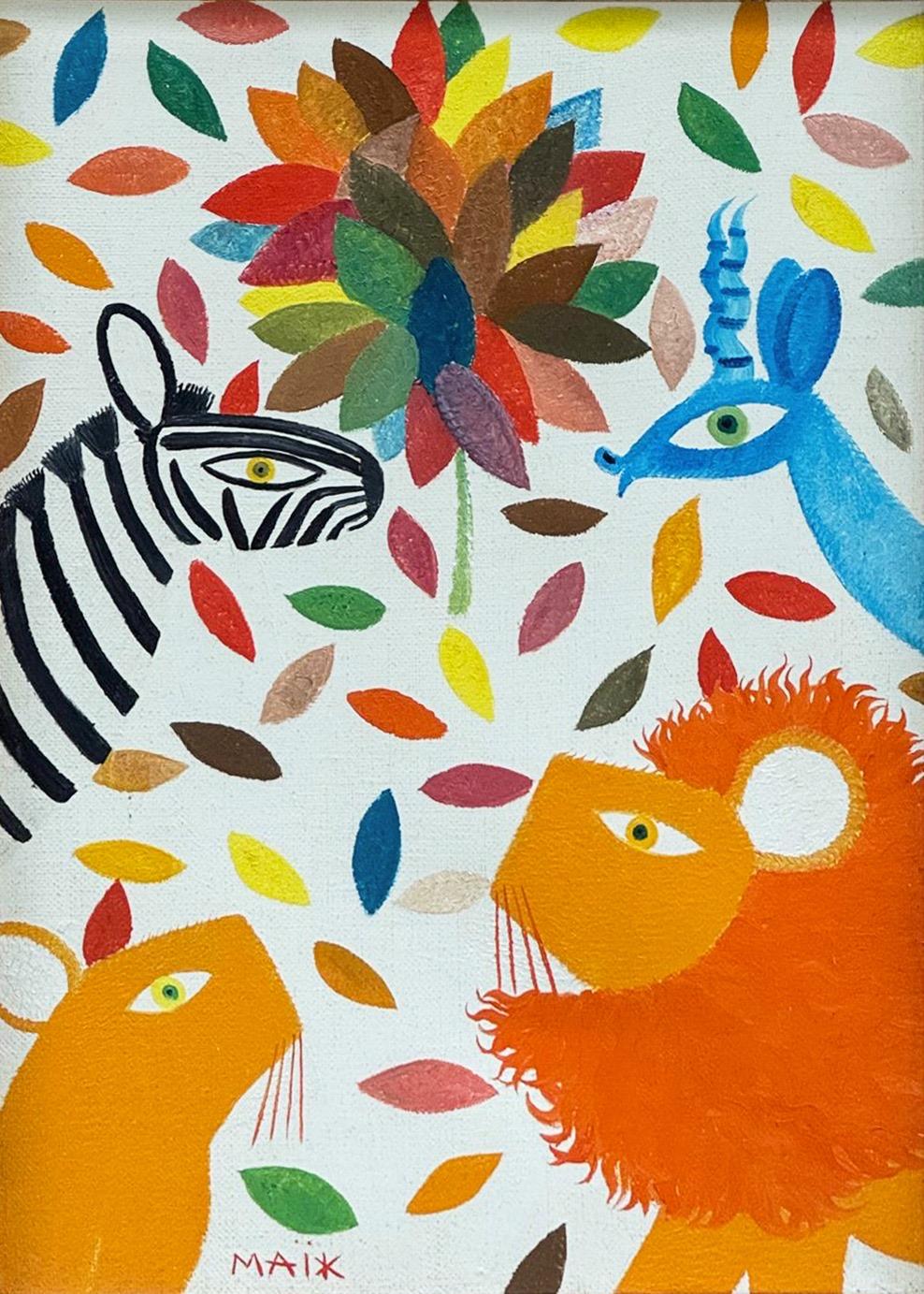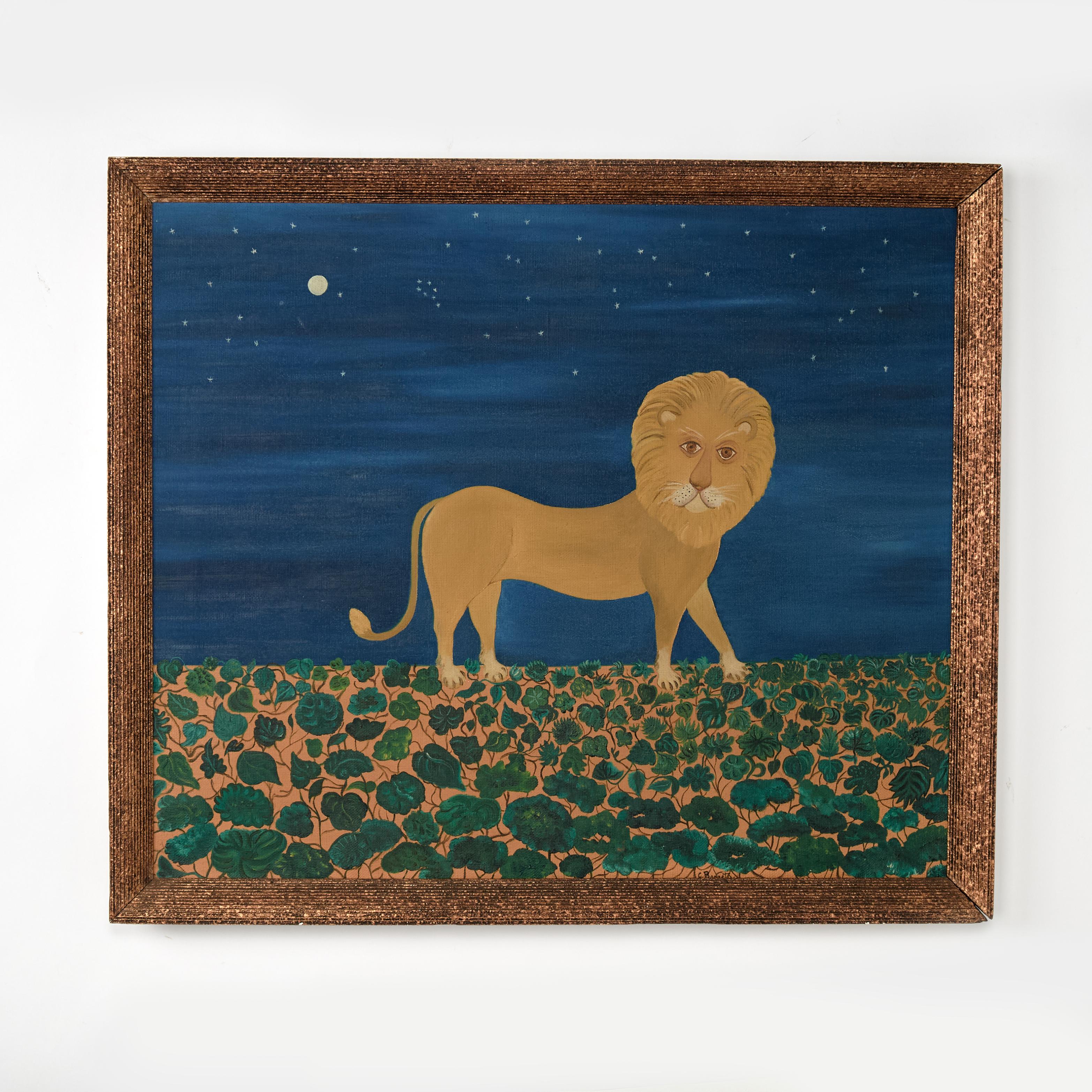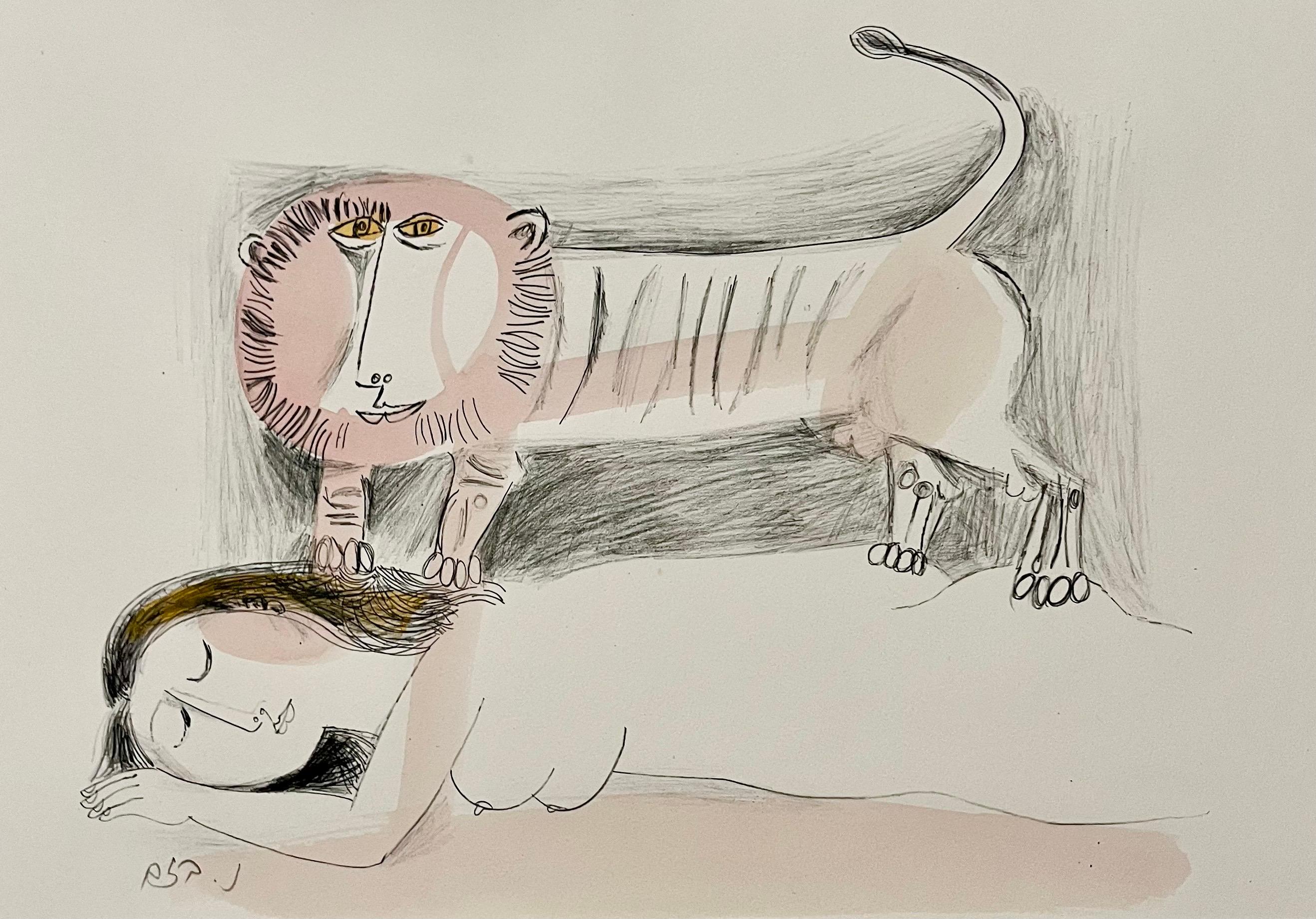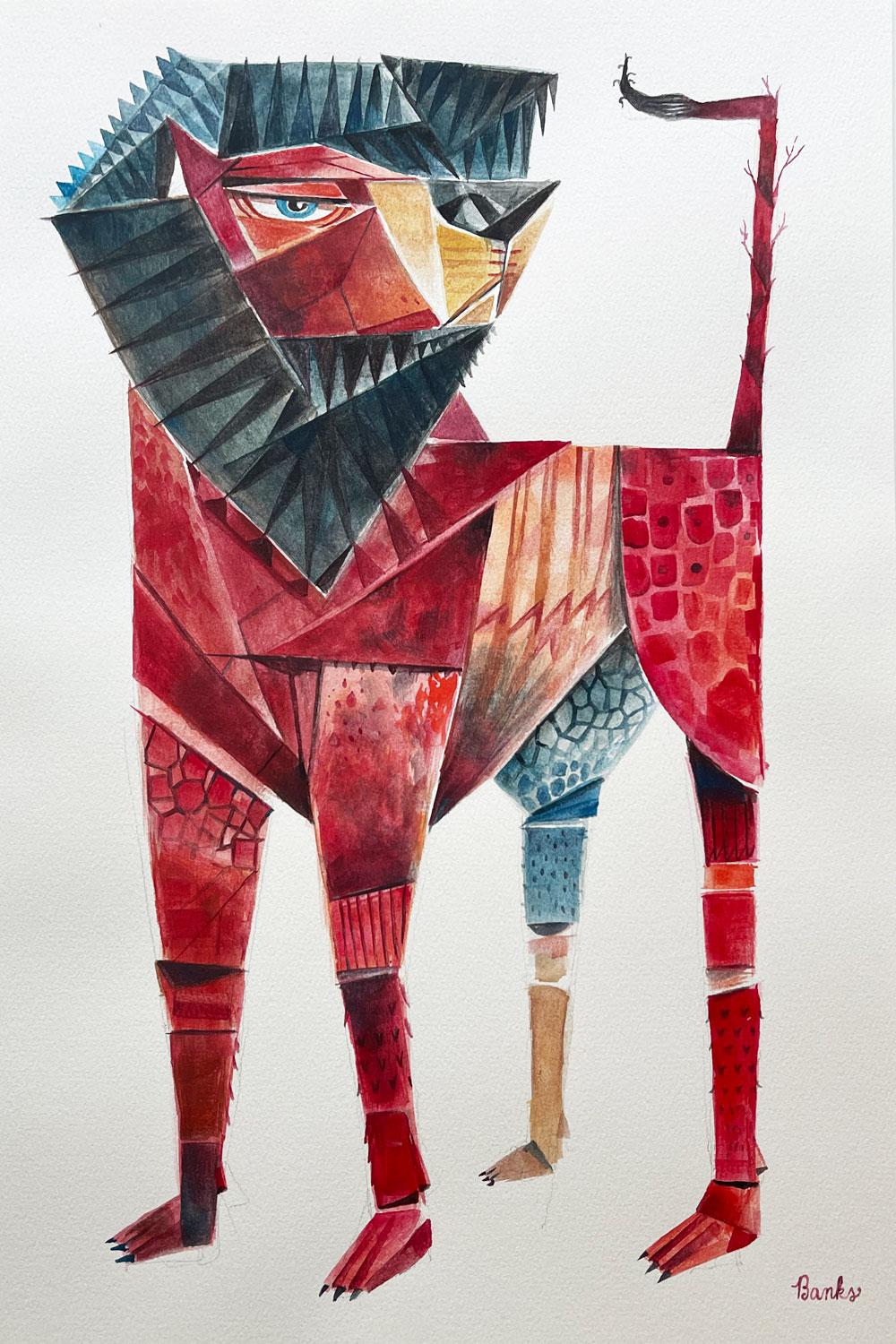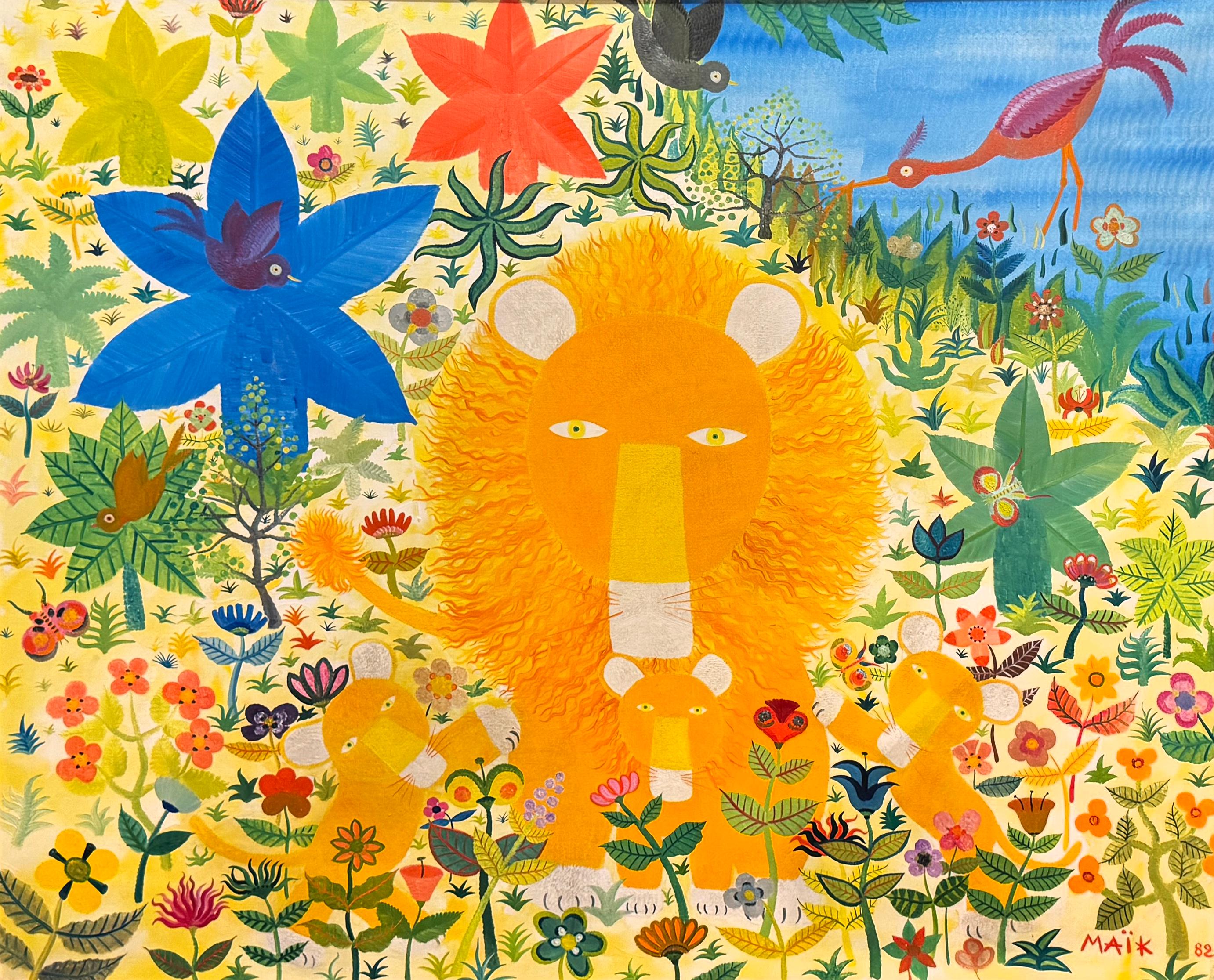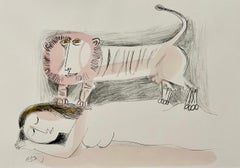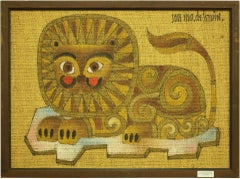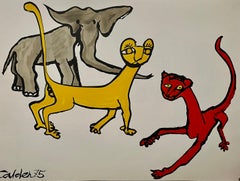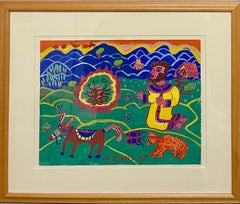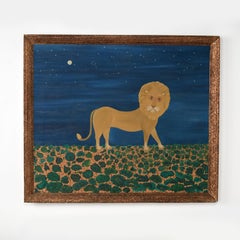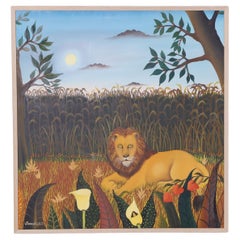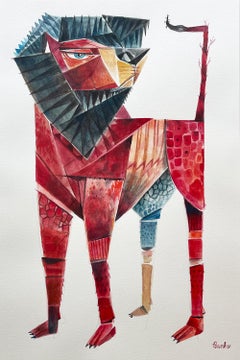Items Similar to Original Oil Painting LIONS in a Modernist Illustration Mod Naive Graphic Style
Want more images or videos?
Request additional images or videos from the seller
1 of 9
Lionel KalishOriginal Oil Painting LIONS in a Modernist Illustration Mod Naive Graphic Stylec.1960s
c.1960s
$3,200
£2,413.12
€2,790.89
CA$4,489.58
A$4,990.45
CHF 2,615.89
MX$60,945.47
NOK 32,657.84
SEK 30,724.94
DKK 20,830.36
About the Item
33.5x27, sight size 28x22
Lionel Kalish born 1931 New York, NY A painter and childrens book illustrator.
Education: 1951 Cooper Union of the Advancement of Science and Art, New York, NY
Selected Solo Exhibitions:
1978 Forum Gallery, New York, NY
1980 Galerie Brusberg, Hannover, Germany
1981 ACA Galleries, New York, NY
1982 Galerie Stubler, Frankfurt Germany
1984 Galerie Brusberg, Berlin, Germany
1990 Sid Detuch Gallery, New York, NY
1994 Lewis Newman Galleries, Beverly Hills, CA
Galerie Brusberg, Berlin, Germany
1996 The Horwitch Newman Gallery, “Italy: The Poetry of Landscape,” Scottsdale, AZ
Gremillion & Co. Fine Arts, “Italy: The Timeless Landscape,” Houston, TX
1997 Hoorn-Hashby Gallery, “Color and Light: The Italian Façade,” New York, NY
1998 Hoorn-Hashby Gallery, “Sun and Shadow: A Mediterranean Vision,” Nantucket, MA
2000 Hoorn-Hashby Gallery, “Italy: Visual Poetry,” New York, NY like Seymour Chwast, Sid Chafetz, Saul Bass, Ivan Chermayeff, Milton Glaser, Paul Rand, Ikko Tanaka, Henryk Tomaszewski a great modernist illustration style.
Selected group Exhibitions:
1975 Galerie Brusberg, Hannover, Germany
1977 Forum Gallery, New York, NY
1978 Forum Gallery, “Fourteen Still Life Paintings: A New York Sensibility,” New York, NY
1979 Galerie Brusberg, “Neuerwerbungen der Galerie,” Hannover, Germany
National Academy of Design: 154th Annual Exhibition, New York, NY
Forum Gallery, “Artists and Sculptors of Forum,” New York, NY
1980 Galerie Brusberg, “Malerei der Gegenwart,” Hannover, Germany
Basel Art Fair, “Sie, She, Elle,” Switzerland
The Butler Institute of American Art, “45th Annual Midyear Show,” Youngstown, OH
1981 Oklaoma Art Center, “New York Gallery Shocase,” Oklaoma City, OK
1982 Galerie Brusberg, West Berlin, Germany
1983 AKA Galleries, New York, NY
1984 Galerie Stubler, Frankfurt, Germany
1985 AKA Galleries, New York, NY
1986 Galerie Brusberg, West Berlin, Germany
1987 Galerie Brusberg, West Berlin, Germany
1988 Galerie Brusberg, West Berlin, Germany
National Academy of Design: 163rd Annual Exhibition, New York, NY
1989 Sid Detusch Gallery, “American Masters; Inaugural Exhibition,” New York, NY
1990 Contemporary Realist Gallery, “The Italian Landscape,” San Francisco, CA
Arkansas Art Center, Annual Collector’s Exhibition
1990 Gremillion & Co. Fine Arts, Houston, TX
1991 Sid Detusch Gallery, New York, NY
Galerie Brusberg, Berlin, Germany
Gremillion & Co. Fine Arts, Houston, TX
1992 Galerie Brusberg, Berlin, Germany
Gremillion & Co. Fine Arts, Houston, TX
1993 Lewis Newman Gallery, Beverly Hills, CA
Gremillion & Co. Fine Arts, Houston, TX
1994 Lewis Newman Galleries, “Contemporary Perspectives,” Beverly Hills, CA
1995 Horwitch Newman Gallery and Koplin Gallery, Santa Monica, CA
Horwitch Newman Gallery, “About American Realism,” Scottsdale, AZ
1996 Horwitch Newman and Jerry Solomon Gallery, ‘An LA Premiere,” Los Angeles, CA
1997 Pennsylvania Academy of Fine Arts, “U.S. Artists ’97”
1998 Pennsylvania Academy of Fine Arts, “U.S. Artists ’98”
Galerie Brusberg, Berlin, Germany
1999 Pennsylvania Academy of Fine Arts, “U.S. Artists ’99”
2000 Horn-Ashby Gallery, Nantucket, MA
Gremillion & Co. Fine Arts, Houston, TX
SELECTED COLLECTIONS
Credit Suisse, New York, NY
Jenswold, King & Associates, Houston, TX
H. Seward Johnson, New York, NY
Exxon Collection
- Creator:Lionel Kalish (1931, American)
- Creation Year:c.1960s
- Dimensions:Height: 33.5 in (85.09 cm)Width: 27 in (68.58 cm)
- Medium:
- Movement & Style:
- Period:
- Condition:needs new mat and frame. staining to mat lower right does not affect image.
- Gallery Location:Surfside, FL
- Reference Number:1stDibs: LU38212687902
About the Seller
4.9
Platinum Seller
Premium sellers with a 4.7+ rating and 24-hour response times
Established in 1995
1stDibs seller since 2014
1,800 sales on 1stDibs
Typical response time: <1 hour
- ShippingRetrieving quote...Shipping from: Surfside, FL
- Return Policy
Authenticity Guarantee
In the unlikely event there’s an issue with an item’s authenticity, contact us within 1 year for a full refund. DetailsMoney-Back Guarantee
If your item is not as described, is damaged in transit, or does not arrive, contact us within 7 days for a full refund. Details24-Hour Cancellation
You have a 24-hour grace period in which to reconsider your purchase, with no questions asked.Vetted Professional Sellers
Our world-class sellers must adhere to strict standards for service and quality, maintaining the integrity of our listings.Price-Match Guarantee
If you find that a seller listed the same item for a lower price elsewhere, we’ll match it.Trusted Global Delivery
Our best-in-class carrier network provides specialized shipping options worldwide, including custom delivery.More From This Seller
View AllRare Israeli Modernist Judaica Watercolor Painting Lion Lithograph Naftali Bezem
By Naftali Bezem
Located in Surfside, FL
Naftali Bezem (Hebrew: נפתלי בזם; born November 27, 1924) is an Israeli painter, muralist, and sculptor. Lion on nude figure of wo,man.
Bezem was born in Essen, Germany, in 1924. H...
Category
20th Century Modern Figurative Drawings and Watercolors
Materials
Watercolor, Lithograph
Mexican Whimsical Folk Art Lion Painting Animalia
By Jose Maria de Servin
Located in Surfside, FL
Painting on burlap by Jose Maria de Servin of an Abstract Naive Lion animal using bright colors and geometric patterns. In this piece the artist simplifies the representation of the ...
Category
Mid-20th Century Folk Art Animal Paintings
Materials
Burlap, Oil
Elephant, Lions Bold Color Lithograph Alexander Calder Unfinished Revolution
By Alexander Calder
Located in Surfside, FL
1975 Color Lithograph by Alexander Calder
from Our Unfinished Revolution portfolio
One of 250 copies, with the printed signature and date on offset paper.
This is not pencil signed ...
Category
1970s American Modern Abstract Prints
Materials
Lithograph
Malcah Zeldis Folk Art Gouache Moses Bible Painting Self Taught Outsider Artist
Located in Surfside, FL
MALCAH ZELDIS (American-Israeli, b. 1931)
Moses and the burning bush, 1982, gouache on paper,
Hand signed and dated lower middle.
Paper 9''h, 11-3/4''w. Framed 14.5 X 17.5
Provenance: Estate of Laura...
Category
1980s Folk Art Figurative Paintings
Materials
Paper, Gouache
Israeli Kibbutz Artist Judaica Shul Torah Ark Surrealist Gouache Painting
By Leo Roth
Located in Surfside, FL
Leo Roth (1914–2002), also known as Lior Roth, was an Israeli painter, born in 1914 in Austria-Hungary. (later Poland)
In 1920, Roth moved to Germany and, in 1933, immigrated to Palestine. He studied at the École des Beaux-Arts in Paris and completed frescoes in Italy and France in the 1950s. Roth first settled in Tel Aviv, then moved to Kvutzat Kinneret, then finally to Kibbutz Afikim where he remained until his death. He served as Director of the Art Academy of the Kibbutzim. In 1959, he was awarded the Jordan Valley Prize for Painting. Roth exhibited in the United States, Israel, Mexico, Spain, Holland, Sweden, and Denmark. He died in 2002.
Education:
1930 School of Art, Duisberg-Hamborn, Germany, under Josef Doppelfeld
Academy of Fine Arts, Hamburg, Germany
1951 Fresco and mural painting, Ecole nationale superiere des Beaux-Arts, Paris, France
1951 fresco in Italy
Teaching:
Director of Art Academy of the Kibbutzim
Roth's work was influenced by Cubism and bears much in common with the work of compatriot painter Naftali Bezem. His colourful canvases contain biblical imagery and references to early Israeli pioneer culture.
Selected Solo Exhibitions
2015 Home, Montefiore Art Gallery, Tel Aviv
2009 Kibbutz Machanayim Art Gallery
2000 Retrospective, Museum of Art, Kibbutz Ein Harod
1997 Oil paintings, Kibbutz Machanayim Art Gallery
1993 Solo Exhibition, Beit Yad Lebanim, Tiberias
1983 Oil paintings, ''Bet-Emanuel'', Ramat Gan
1980 Wilfrid Israel Museum, Oriental Art and Studies, Kibbutz Hazorea
1977 Tiroche Gallery, Old Jaffa
1976 Hatzrif Art Gallery, Be'er Sheva
1957 Oil paintings, Tel Aviv Art Museum
1950 Katz Gallery, Tel AvivSelected exhibitions
2000: Chaim Atar Art Museum, Ein Harod, Israel: The Works of Leo Roth: An Exhibition
Selected Group Exhibitions
2014 Revelations, Jerusalem Print Workshop
2013 Group Exhibition, Yair Art Gallery, Tel Aviv
2008 The First Decade: Hegemony and Plurality, Ein Harod Art Museum
2000 Group...
Category
20th Century Surrealist Interior Paintings
Materials
Paper, Gouache
Untitled Couple Mid Century Jewish Expressionist OIl Painting
By Belle Golinko
Located in Surfside, FL
Abstracted painting of a man and a woman, the paint has been applied to textured plastic.
An abstracted painting of a couple applying paint to the textured plastic surface. Genre Expressionist Fauvist Subject People Medium Acrylic Plastic Surface Board Country United States Dimensions 24" x 11 1/2"
She exhibited her painting at the famous Jewish art show held at the Dallas Museum
Contemporary Fine Arts Exhibition of the American Jewish Tercentenary in 1955 alogside artists Aarons, George, Benn, Ben, Berkman, Aaron, Bloom, Hyman
Bohrod, Aaron Gottlieb, Adolph, Gropper, William, Gross, Chaim Gurr, Lena amongst others.
Born in 1899, Belle Golinko is a listed Jewish mid...
Category
1950s Expressionist Figurative Paintings
Materials
Plastic, Oil
You May Also Like
Wally Findlay Naive OIL PAINTING South African ZEBRA LION & Gazelles
By Henri Maik
Located in New York, NY
Henri Maik
Oil on Canvas
13x10 inches painting alone
21x17 inches with frame
Signed lower left
Wally Findlay Gallery label verso
Charming painting by Henri Maik, image depicts a Lio...
Category
1970s Post-Modern Animal Paintings
Materials
Acrylic
Vintage Italian Folk Art Painting on Canvas of a Lion
Located in Palm Beach, FL
Whimsical Italian oil painting on canvas of a lion in a night sky with stars and a moon, executed in a distinctive primitive naive style. Signed on the bottom C. Barreto and noted on...
Category
21st Century and Contemporary Folk Art Animal Paintings
Materials
Oil
Vintage Painting on Canvas of a Lion by Blanko Paradis
Located in Palm Beach, FL
Enchanting mid century acrylic painting on canvas of an aging lion in repose with flowers and trees, executed in a charming naive style. Signed Paradis 81 and presented in a wood frame.
Category
Late 20th Century American Mid-Century Modern Paintings
Materials
Canvas, Acrylic
Lion Guard, Original Painting
Located in San Francisco, CA
Artist Comments
A majestic lion stands sentinel. Its piercing eye and towering mane evoke strength and silent vigilance. Bold geometric planes and vivid color give life to its ...
Category
21st Century and Contemporary Contemporary Animal Drawings and Watercolors
Materials
Watercolor
Henri Maïk "Les trois freres" oil/canvas of Lion Cubs Birds Flowers 1982 FRENCH
By Henri Maik
Located in Rancho Santa Fe, CA
An oil on canvas by HENRI MAIK (French) titled "Les trois freres" depicts a Lion, Lion Cubs, Birds & Flowers. Painted in 1982.
Signed and dated lower right
Signed and titled verso
...
Category
1980s Post-Modern Animal Paintings
Materials
Canvas, Oil
Always A Leo - Figurative Lion Painting on Paper
By Kellie Newsome
Located in Los Angeles, CA
Columbus, Georgia (USA) based artist Kellie Newsome specializes in dynamic and abstracted still-life artworks. Her expressive style emphasizes line structure, creating vibrant painti...
Category
2010s Contemporary Animal Paintings
Materials
Paper, Mixed Media, Acrylic, Color Pencil
More Ways To Browse
Naive Art Painting
Paintings Of Lions
Animal Art Lions
Oil Paintings Naive
Vintage Illustration Children
1960s Italian Oil
Vintage Lion Painting
Lion Paintings
Lion Contemporary Painting
Nantucket Painting
Naive Animal
1960s German Oil Paintings
Oil Painting Of A Lion
Newman Oil Paintings
Nantucket Oil Paintings
Lion Oil Paintings
Naive Art Germany
C S Lewis
